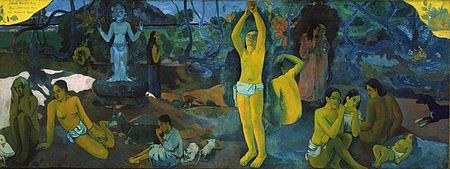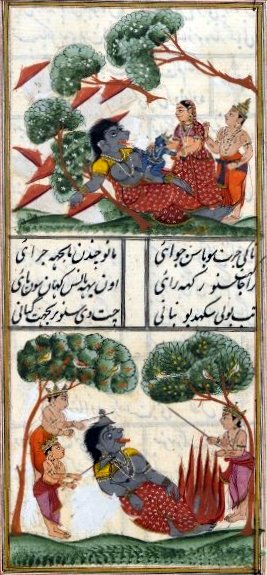Putana
|
Read other articles:

Mammalian protein found in Homo sapiens DLX4IdentifiersAliasesDLX4, BP1, DLX7, DLX8, DLX9, Dlx-4, OFC15, distal-less homeobox 4External IDsOMIM: 601911 MGI: 94904 HomoloGene: 7292 GeneCards: DLX4 Gene location (Human)Chr.Chromosome 17 (human)[1]Band17q21.33Start49,968,970 bp[1]End49,974,959 bp[1]Gene location (Mouse)Chr.Chromosome 11 (mouse)[2]Band11 D|11 59.01 cMStart95,031,273 bp[2]End95,037,089 bp[2]RNA expression patternBgeeHumanMouse (ort…

Флаг гордости бисексуалов Бисексуальность Сексуальные ориентации Бисексуальность Пансексуальность Полисексуальность Моносексуальность Сексуальные идентичности Би-любопытство Гетерогибкость и гомогибкость Сексуальная текучесть Исследования Шка�…

内華達州 美國联邦州State of Nevada 州旗州徽綽號:產銀之州、起戰之州地图中高亮部分为内華達州坐标:35°N-42°N, 114°W-120°W国家 美國建州前內華達领地加入聯邦1864年10月31日(第36个加入联邦)首府卡森城最大城市拉斯维加斯政府 • 州长(英语:List of Governors of {{{Name}}}]]) • 副州长(英语:List of lieutenant governors of {{{Name}}}]])喬·隆巴爾多(R斯塔夫�…

District in the country of Japan This article does not cite any sources. Please help improve this article by adding citations to reliable sources. Unsourced material may be challenged and removed.Find sources: Sorachi District, Hokkaido – news · newspapers · books · scholar · JSTOR (December 2009) (Learn how and when to remove this message) Sorachi District in Sorachi and Kamikawa Subprefecture. Sorachi (空知郡, Sorachi-gun) is a district divided betwe…

Species of true bug Not to be confused with harlequin beetle. Harlequin cabbage bug Adult (left) and nymph (right) Scientific classification Domain: Eukaryota Kingdom: Animalia Phylum: Arthropoda Class: Insecta Order: Hemiptera Suborder: Heteroptera Family: Pentatomidae Genus: Murgantia Species: M. histrionica Binomial name Murgantia histrionica(Hahn, 1834) Aggregated nymphs The harlequin cabbage bug (Murgantia histrionica), also known as calico bug, fire bug or harlequin bug, is a black st…

此條目可能包含不适用或被曲解的引用资料,部分内容的准确性无法被证實。 (2023年1月5日)请协助校核其中的错误以改善这篇条目。详情请参见条目的讨论页。 各国相关 主題列表 索引 国内生产总值 石油储量 国防预算 武装部队(军事) 官方语言 人口統計 人口密度 生育率 出生率 死亡率 自杀率 谋杀率 失业率 储蓄率 识字率 出口额 进口额 煤产量 发电量 监禁率 死刑 国债 外…

Under-18 men's ice hockey tournament 2023 IIHF U18 World ChampionshipTournament detailsHost country SwitzerlandVenue(s)2 (in 2 host cities)Dates20–30 AprilTeams10Final positionsChampions United States (11th title)Runner-up SwedenThird place CanadaFourth place SlovakiaTournament statisticsGames played30Goals scored218 (7.27 per game)Attendance47,087 (1,570 per game)Scoring leader(s) Will Smith (20 points)Website…

Chemical compound This article is about the synthetic cannabinoid drug. For the Japanese girl idol group, see AKB48. APINACALegal statusLegal status BR: Class F2 (Prohibited psychotropics)[1] CA: Schedule II DE: Anlage II (Authorized trade only, not prescriptible) NZ: Temporary Class UK: Class B US: Schedule I Also illegal in Czech Republic, Japan, Latvia, and Singapore Identifiers IUPAC name N-(1-Adamantyl)-1-pentylindazole-3-carboxamide CAS Number1345973-5…

1Sampul edisi regulerAlbum studio karya B1A4Dirilis24 Oktober 2012 (2012-10-24)Direkam2011–2012GenreJ-pop, Dance-popBahasaJepangLabelPony CanyonKronologi B1A4 Ignition(2012)Ignition2012 1(2012) In the Wind(2012)In the Wind2012 Singel dalam album 1 Beautiful TargetDirilis: 27 Juni 2012 Oyasumi Good NightDirilis: 29 Agustus 2012 1 adalah album studio debut berbahasa Jepang boy band asal Korea Selatan B1A4. Album ini dirilis pada tanggal 24 Oktober 2012 dalam tiga edisi yang berbeda.[…

Частина серії проФілософіяLeft to right: Plato, Kant, Nietzsche, Buddha, Confucius, AverroesПлатонКантНіцшеБуддаКонфуційАверроес Філософи Епістемологи Естетики Етики Логіки Метафізики Соціально-політичні філософи Традиції Аналітична Арістотелівська Африканська Близькосхідна іранська Буддійсь…

A map of the historical Tadla region and its tribes. Tadla is a historical and geographical region of Morocco, located in the center of the country, north of the High Atlas mountain range and west of the Middle Atlas. It is the region of origin of the eponymous collection of tribal, semi-nomadic pastoralist population, the Tadla tribes. Nowadays, the historical region of Tadla is mainly part of the administrative region of Béni Mellal-Khénifra, except for the historical territory of the Beni M…

2014 book by Alon Confino For the translation of Marx's On the Jewish Question, see A World Without Jews (1959 book). Book cover A World Without Jews: The Nazi Imagination from Persecution to Genocide is a 2014 book by Alon Confino published by Yale University Press, which seeks to explain Nazi antisemitism and the Holocaust by looking into the imaginations and fantasies of Nazis. It received mixed reviews in scholarly and popular publications. Some reviewers praised Confino's analysis for its o…

Chronologies Le président Pávlos Koundouriótis serre la main d'un policier après une tentative d'assassinat sur sa personne.Données clés 1924 1925 1926 1927 1928 1929 1930Décennies :1890 1900 1910 1920 1930 1940 1950Siècles :XVIIIe XIXe XXe XXIe XXIIeMillénaires :-Ier Ier IIe IIIe Chronologies géographiques Afrique Afrique du Sud, Algérie, Angola, Bénin, Botswana, Burkina Faso, Burundi, Cameroun, Cap-Vert, République cen…

Building in Kandy, Sri LankaHotel SuisseGeneral informationLocationKandy, Sri LankaAddress30 Sangaraja Mawatha, Kandy, Sri Lanka.Coordinates7°17′18.24″N 80°38′34.44″E / 7.2884000°N 80.6429000°E / 7.2884000; 80.6429000OwnerCeylon Hotels CorporationManagementGalle Face Hotel ManagementTechnical detailsFloor count4Other informationNumber of rooms83Number of suites7Number of restaurants1Websitehttp://www.hotelsuisse.lk/ The Hotel Suisse is a heritage hotel located…

阿拉伯也门共和国الجمهوريّة العربية اليمنية1962年—1990年 国旗 国徽 国歌:《和平归大地》(1962年-1978年) 《一个国家的意志(英语:A Nation's Will)》(1978年-1990年)首都萨那常用语言阿拉伯语政府军政府领导下的单一制一党制共和國總統 總理 历史时期冷戰• 建立 1962年9月26日• 統一 1990年5月22日 面积1986年195,000平方公里人口• 1986年 9274173 …

Varangian chieftain of the Rus' For other people with the given name Rurik or Ryurik, see Rurik (given name). For the ships, see Russian ship Rurik. For the dynasty, see Rurik dynasty. RurikPrince of NovgorodRurik on the 19th century Millennium of Russia monument in Veliky NovgorodReign862–879[a]SuccessorOlegDied879[a]NovgorodIssueIgorDynastyRurikReligionNorse paganism Rurik (also spelled Rorik, Riurik or Ryurik;[1][2][3][4] Church Slavonic: Рю…

لأجل مسلسل الرسوم المتحركة الياباني مذكرة الموت، انظر مذكرة الموت انتحار الجوانب الاجتماعية التشريعات الاجتماعية الفلسفة نظرة الأديان للانتحار قتل رحيم حق الموت الانتحار المبرر أزمة الانتحار تقييم خطر الانتحار خط الأزمة الساخن الوقاية من الانتحار منع الانتحار الانتحار �…

متحف باكو للفن الحديث إحداثيات 40°22′41″N 49°51′53″E / 40.378018°N 49.86469°E / 40.378018; 49.86469 معلومات عامة الموقع أذربيجان الدولة أذربيجان سنة التأسيس 20 مارس 2009 تاريخ الافتتاح الرسمي 2009 معلومات أخرى الموقع الإلكتروني الموقع الرسمي تعديل مصدري - تعديل …

1907 – MCMVII117 år sedan År1904 | 1905 | 190619071908 | 1909 | 1910 Årtionde1880-talet | 1890-talet 1900-talet1910-talet | 1920-talet Århundrade1800-talet 1900-talet2000-talet Årtusende1000-talet Året Födda | AvlidnaBildanden | Upplösningar Humaniora och kultur Film | Konst | Litteratur | Musik | Serier | Teater Samhällsvetenskapoch samhälleKrig | Politik | Sport Teknik och vetenskap Vetenskap Andra tideräkningar Greg…

Croatian politician and revolutionary (1825–1871) For the Croatian Ustaše General-Lieutenant of the same name, see Eugen Dido Kvaternik. This article has multiple issues. Please help improve it or discuss these issues on the talk page. (Learn how and when to remove these template messages) This article may need to be rewritten to comply with Wikipedia's quality standards. You can help. The talk page may contain suggestions. (April 2016) This article may be confusing or unclear to readers. Ple…





